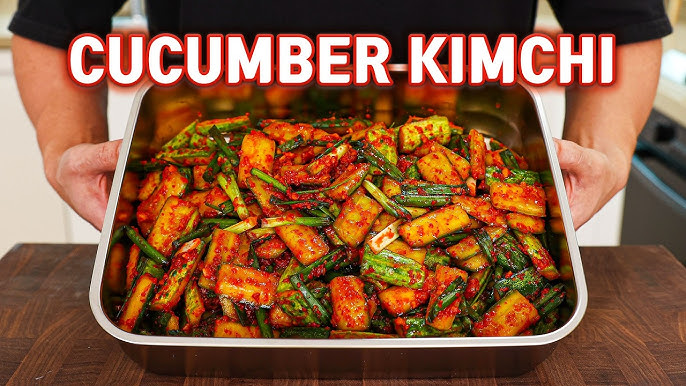Cucumber Kimchi Recipe: If you love spicy, crunchy, and refreshingly tangy foods, cucumber kimchi is going to be your new go-to side dish. It’s fast, flavorful, and doesn’t require days of fermentation like traditional napa cabbage kimchi.
Whether you’re a kimchi connoisseur or a beginner trying Korean cuisine for the first time, this guide will take you through every step to make mouth-watering cucumber kimchi at home.
What is Cucumber Kimchi?
Cucumber kimchi, also known as “Oi Kimchi” or “Oi Sobagi” in Korean, is a refreshing twist on the more commonly known cabbage-based kimchi. It features crisp cucumbers filled or mixed with a spicy, garlicky, umami-rich paste made from Korean red pepper flakes, garlic, green onions, and often a hint of fermented seafood or fish sauce.
Unlike traditional kimchi, which requires lengthy fermentation, cucumber kimchi is often enjoyed fresh or after a short ferment. This makes it an excellent choice when you want the bold flavors of kimchi without the wait.
One of the standout traits of cucumber kimchi is its crunch. When prepared right, each bite bursts with flavor—sweet, salty, sour, and spicy all at once. It’s a great side for grilled meats, rice dishes, or even just on its own as a low-calorie snack.
Health Benefits of Cucumber Kimchi
Rich in Probiotics
Just like any fermented food, cucumber kimchi is a powerhouse of probiotics. These good bacteria help support gut health, digestion, and overall immune function. Even a short fermentation time can yield beneficial microbes that keep your digestive system happy.
Probiotics have also been linked to better mental health, weight management, and even clearer skin. So incorporating cucumber kimchi into your meals isn’t just about taste—it’s also about wellness.
Low in Calories, High in Nutrients
Cucumbers are about 95% water, making this kimchi naturally hydrating and low in calories. But don’t be fooled—it’s still packed with vitamins like vitamin K, B vitamins, and minerals such as potassium and magnesium.
The garlic, ginger, and red pepper flakes used in the paste bring their own nutritional perks to the table. Garlic supports heart health, ginger fights inflammation, and chili peppers can boost your metabolism. It’s a small dish with big nutritional impact.
Ingredients You’ll Need
Core Ingredients
Here’s your shopping list for classic cucumber kimchi:
- 4–6 small Korean cucumbers or Persian cucumbers (or 3 English cucumbers)
- 2 tablespoons sea salt (for salting)
- 4 garlic cloves (minced)
- 1 teaspoon grated ginger
- 2 tablespoons Korean red pepper flakes (gochugaru)
- 2 teaspoons fish sauce (or soy sauce for a vegetarian version)
- 1 teaspoon sugar
- 2 green onions (chopped)
- 1 small carrot (julienned – optional)
- ½ onion (thinly sliced – optional)
These ingredients form the base of a spicy, tangy, crunchy kimchi. The beauty of homemade kimchi is you can always adjust the spice level or switch up the add-ins based on your preferences.
Optional Add-ons for Flavor Variations
If you like your kimchi extra funky or layered with flavors, consider adding:
- 1 tablespoon fermented shrimp or anchovy sauce
- A handful of chopped Asian chives
- Toasted sesame seeds
- Sliced radish or daikon
You can even throw in some apple or pear slices for a touch of sweetness. Just be cautious not to overload it, as too many watery ingredients can affect the texture.
Equipment Required
You don’t need anything fancy to make cucumber kimchi. Just grab:
- A sharp knife
- Cutting board
- Large mixing bowl
- Gloves (highly recommended when mixing the spicy paste)
- Clean glass jar or container with lid for storing
Sterilizing your jar beforehand can help prolong the life of your kimchi and prevent any unwanted bacteria from spoiling the batch.
Preparing the Cucumbers
Washing and Cutting
Start with fresh, firm cucumbers. Wash them thoroughly under cold water. If you’re using thick-skinned cucumbers like English cucumbers, you may want to peel some of the skin off for better flavor absorption.
Slice them into 2-3 inch long pieces. Then, quarter each piece lengthwise without cutting all the way through. Think of it like creating little pockets or “flower” shapes—this is where the spicy paste will go if you’re stuffing them. If not stuffing, you can simply slice the cucumbers into spears or rounds.
Salting the Cucumbers
Next, place the cucumbers in a bowl and sprinkle them with sea salt. Toss to coat evenly. Let them sit for 30-40 minutes, tossing occasionally. This process draws out excess water, helping the cucumbers stay crisp and absorb more flavor later on.
After salting, rinse the cucumbers a couple of times under cold water to remove the excess salt. Pat them dry using a paper towel or clean kitchen cloth. Now your cucumbers are ready for the spice party!
Making the Kimchi Paste
Spicy Paste Basics
Now for the heart of the dish—the kimchi paste. This fiery red mixture is what transforms plain cucumbers into flavor bombs. In a bowl, combine the minced garlic, grated ginger, gochugaru (Korean red pepper flakes), fish sauce (or soy sauce for vegans), sugar, and a splash of water. Mix it well until it forms a thick, spreadable paste.
The sugar helps balance the heat, and the fish sauce gives it that deep umami flavor. For a more complex taste, you can add a bit of fermented shrimp or anchovy sauce. This will enhance the traditional kimchi tang but can be omitted if you prefer a milder or vegetarian version.
You want the paste to be thick enough to cling to the cucumbers without being too watery. Adjust the water or gochugaru ratio accordingly. If you’re stuffing the cucumbers, this paste should fill those little cucumber pockets perfectly.
Adjusting Spice Levels
Not everyone loves intense heat—and that’s totally fine! You can dial down the spice by reducing the amount of gochugaru. You can also substitute a portion of it with sweet paprika for color without the fire. On the flip side, if you like it blazing hot, add more gochugaru or toss in a bit of finely chopped Thai chili.
Remember, the paste is the flavor core, so taste as you go. Want a hint of sweetness? A bit more sugar. Prefer a punchier taste? Add an extra dash of fish sauce or minced onion. Make it yours.
Mixing It All Together
Now comes the fun part—bringing everything together. If you’re stuffing your cucumbers, use a small spoon or your fingers (wear gloves!) to gently open each cucumber pocket and stuff it with the spicy paste.
If you’re not stuffing and are using sliced cucumbers instead, just add them to the bowl of paste and gently mix until they’re thoroughly coated. Be careful not to break the cucumbers—they should stay crisp and slightly firm.
You can also add sliced onions, julienned carrots, or radish at this point for extra texture and variety. Make sure everything gets a nice, even coat of the spicy mixture.
Let it sit for 20-30 minutes before serving to allow the flavors to meld. If you’re going to ferment it longer, pack the mixture into a clean glass jar or container, pressing it down to remove air pockets.
Fermenting the Kimchi
Room Temperature Fermentation
If you’re aiming for that iconic kimchi tang, fermentation is the key. After packing the kimchi into your jar, leave it at room temperature for 12–24 hours, depending on the temperature and your taste preference. The warmer your kitchen, the faster it ferments.
You’ll notice bubbles and a slight sour aroma—both signs that the fermentation is working. Once it reaches your preferred level of tanginess, transfer it to the fridge to slow down the process.
Keep in mind, cucumber kimchi ferments faster than cabbage kimchi due to its high water content, so keep a close eye on it.
Refrigeration Tips
Once fermented to your liking, store the kimchi in the fridge. It will continue to develop flavor over time but much more slowly. Ideally, eat cucumber kimchi within 1–2 weeks while it’s still crunchy and fresh.
Always use clean utensils when scooping kimchi from the jar to prevent contamination. You can even portion it into smaller containers to make it last longer and retain that perfect crispiness.
How to Store Your Cucumber Kimchi
Proper storage is essential to maintain the flavor and texture of your cucumber kimchi. After initial fermentation, always refrigerate the kimchi in a tightly sealed glass jar or airtight container.
Here are some tips to keep it fresh:
- Use clean utensils every time you serve it to avoid introducing bacteria.
- Don’t fill the jar to the brim—leave a bit of headspace for gases to expand during fermentation.
- Label the container with the date so you can track fermentation progress.
If your kimchi gets too sour for your taste, don’t toss it! It’s still usable in stews, stir-fries, or even savory pancakes.
Best Ways to Serve Cucumber Kimchi
Wondering how to enjoy your cucumber kimchi? Here are some mouth-watering ideas:
- As a side dish – The classic way! Pair it with grilled meats, rice, or noodles.
- In lettuce wraps – Add a spoonful of kimchi to grilled meat, rice, and lettuce for a DIY Korean ssam.
- On top of rice bowls – A little kimchi can totally elevate a basic rice bowl.
- In sandwiches or tacos – For a spicy, crunchy twist.
- As a salad – Toss cucumber kimchi with some sesame oil and roasted sesame seeds for a refreshing salad.
Its bold flavors and crisp texture make it a versatile ingredient that complements just about anything savory.
Common Mistakes to Avoid
Cucumber kimchi is fairly easy to make, but a few common pitfalls can lead to soggy textures or lackluster flavor. Let’s break down what not to do so your kimchi turns out just right every time.
1. Skipping the salting step: Salting the cucumbers is crucial. It helps draw out excess moisture and preps the cucumbers to absorb the spicy paste better. If you skip or rush this step, you’ll end up with watery, bland kimchi. Always give your cucumbers enough time to sit in salt, and remember to rinse off the excess afterward.
2. Using too much water in the paste: Adding too much liquid to the kimchi paste can dilute its flavor and make your kimchi soggy. The paste should be thick and cling to the cucumbers. If you find it too dry, add a small amount of water gradually—don’t overdo it.
3. Over-fermenting at room temperature: Cucumber kimchi ferments quickly. Leaving it out for too long can turn it overly sour and mushy. Keep an eye on the fermentation time, especially in warmer climates. 12 to 24 hours at room temperature is usually enough before transferring it to the fridge.
4. Not storing properly: Improper storage leads to faster spoilage. Always use a clean, airtight glass container, and avoid cross-contaminating the kimchi with dirty utensils. Store it in the fridge after fermentation and eat within two weeks for the best flavor and texture.
5. Using the wrong cucumbers: Thick-skinned or seed-heavy cucumbers like standard American cucumbers don’t work well. Go for Korean, Persian, or English cucumbers that are seedless or have very small seeds. They’re firmer, crunchier, and absorb flavor better.
Avoiding these simple mistakes can be the difference between average and extraordinary cucumber kimchi. Practice makes perfect, and each batch will teach you something new about flavor balance and fermentation.
Cucumber Kimchi Vs. Traditional Kimchi
Both cucumber and traditional cabbage kimchi are staples in Korean cuisine, but they bring different vibes to the table. Let’s look at how they compare:
| Feature | Cucumber Kimchi | Traditional Cabbage Kimchi |
|---|---|---|
| Main Ingredient | Cucumbers | Napa Cabbage |
| Fermentation Time | Short (0–2 days) | Long (5–10 days or more) |
| Texture | Crunchy and fresh | Soft and deeply fermented |
| Best Served | Fresh or lightly fermented | Aged for deeper flavor |
| Flavor Profile | Bright, spicy, and refreshing | Funky, tangy, and bold |
| Shelf Life | 1–2 weeks in the fridge | Several months |
Cucumber kimchi is perfect when you want a lighter, quicker version of kimchi that’s still packed with flavor. It’s ideal for summer months or when you need a last-minute side dish. On the other hand, cabbage kimchi is great for cooking and layering into heartier meals due to its deeper fermentation.
If you’re new to making kimchi, cucumber kimchi is an excellent starting point. It’s less intimidating, quicker to prepare, and gives you a taste of the rich, spicy-sour magic of Korean pickles without a long wait.
Quick Tips for Perfect Cucumber Kimchi Every Time
Want to level up your cucumber kimchi game? These tips will keep your batches consistently delicious:
- Choose fresh, firm cucumbers – The fresher they are, the crunchier your kimchi will be.
- Don’t over-salt – Just enough to draw out moisture and enhance flavor. Always rinse well after salting.
- Use authentic Korean ingredients – Gochugaru, fish sauce, and fermented shrimp can make a big difference.
- Taste your paste before mixing – Adjust salt, sugar, and spice levels to match your preferences.
- Ferment in a cool, shaded spot – Keep away from direct sunlight during the initial ferment.
- Use gloves when mixing – Saves your hands from the chili burn and keeps things hygienic.
- Don’t crowd the jar – Pack it in but leave room at the top for gases to escape.
- Label your jars – Always helpful to know when you made the batch and track fermentation time.
By following these tips, you’ll get the perfect balance of spicy, tangy, and crunchy every time you make cucumber kimchi.
FAQs about Cucumber Kimchi Recipe
1. What is cucumber kimchi made of?
Cucumber kimchi, also known as Oi Kimchi, is made from fresh cucumbers, Korean red pepper flakes (gochugaru), garlic, scallions, fish sauce or soy sauce (for a vegetarian option), and sometimes carrots or onions for extra crunch.
2. How long does cucumber kimchi last?
Cucumber kimchi is best enjoyed fresh but can last up to 5–7 days in the refrigerator. Because cucumbers have high water content, they ferment faster and may lose their crunch if stored too long.
3. Is cucumber kimchi spicy?
Yes, it typically has a mild to moderate level of spice due to the gochugaru. You can adjust the heat level to your taste by using less chili flakes.
4. Can I make cucumber kimchi without fish sauce?
Absolutely! You can substitute fish sauce with soy sauce or tamari to make a vegan-friendly version without losing the umami flavor.
5. Do I need to ferment cucumber kimchi?
Unlike traditional napa cabbage kimchi, cucumber kimchi is usually eaten as a quick or fresh kimchi. It can be eaten immediately or left to ferment for a few hours to develop flavor.
6. What type of cucumber is best for kimchi?
Use firm, seedless cucumbers like Persian or Korean cucumbers. Avoid watery varieties like English cucumbers, as they may become too soft.
7. Can I make cucumber kimchi ahead of time?
Yes, it’s a great make-ahead side dish. Just note that it’s crunchiest when eaten within the first 1–3 days after preparation.
8. Is cucumber kimchi healthy?
Definitely! It’s low in calories, rich in probiotics (when slightly fermented), and full of vitamins and antioxidants from fresh vegetables and garlic.
Conclusion
Cucumber kimchi is more than just a side dish—it’s a flavorful, probiotic-packed, refreshing addition to any meal. From its crunchy texture to its spicy punch, this quick kimchi variation has earned its place in the hearts of food lovers around the world. Whether you’re new to fermentation or a seasoned kimchi maker, this guide offers everything you need to make a delicious batch from scratch.
The best part? You can whip it up in under an hour and enjoy it the same day or let it ferment for that extra depth. So grab your cucumbers, spice it up, and enjoy a taste of Korea in your kitchen.



